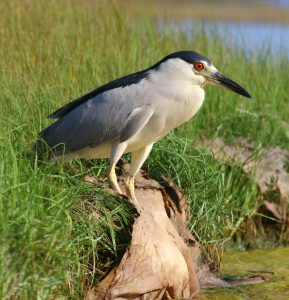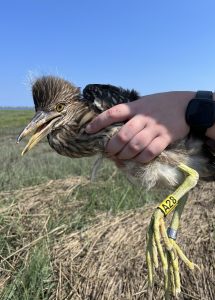by Sam Collins, Research Scientist
 Some of the most iconic species of our coastal wetlands are herons and egrets, which are often observed wading in the open water areas of the marsh trying to catch a quick meal. Unlike conspicuous and easily observed wading birds like Great Egrets and Great Blue Herons, Black-crowned Night-Herons can be very difficult to locate and see. As their name suggests, these herons are most active at dusk, dawn, and at night to avoid competition with other bird species.
Some of the most iconic species of our coastal wetlands are herons and egrets, which are often observed wading in the open water areas of the marsh trying to catch a quick meal. Unlike conspicuous and easily observed wading birds like Great Egrets and Great Blue Herons, Black-crowned Night-Herons can be very difficult to locate and see. As their name suggests, these herons are most active at dusk, dawn, and at night to avoid competition with other bird species.
Here in coastal New Jersey, the Black-crowned Night-Heron has experienced significant population declines in recent decades and is listed as a threatened species in the state. With the largest statewide nesting concentrations for the species located on two islands just north of The Wetlands Institute, scientists in our Research and Conservation department have been closely monitoring these nesting areas to better understand population trends, reproductive success, and changes to nesting habitat suitability. These nesting areas are increasingly at risk with more flooding and storm events that smother desirable habitat with wrack and other debris.
 One major challenge to fully understand the species’ response to changing conditions is our ability to observe these individuals when they are most active, at night. Fortunately, with funding from New Jersey Department of Environmental Protection, our experienced and permitted staff have started monitoring the species through direct and indirect observations of individuals, and use a variety of methods, such as GPS transmitters, to collect data with minimal disturbance. While we are able to measure and mark chicks with unique color-coded bands to help track movements and survival, adults are both secretive and cryptic which makes efforts to capture and mark individuals extremely difficult. If you know of reliable foraging locations for adult Black-crowned Night-Herons in our area, please reach out to research scientist Sam Collins (scollins@wetlandsinstitute.org).
One major challenge to fully understand the species’ response to changing conditions is our ability to observe these individuals when they are most active, at night. Fortunately, with funding from New Jersey Department of Environmental Protection, our experienced and permitted staff have started monitoring the species through direct and indirect observations of individuals, and use a variety of methods, such as GPS transmitters, to collect data with minimal disturbance. While we are able to measure and mark chicks with unique color-coded bands to help track movements and survival, adults are both secretive and cryptic which makes efforts to capture and mark individuals extremely difficult. If you know of reliable foraging locations for adult Black-crowned Night-Herons in our area, please reach out to research scientist Sam Collins (scollins@wetlandsinstitute.org).
